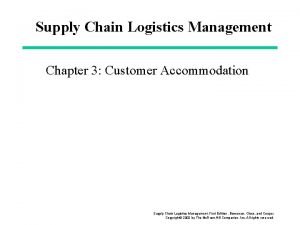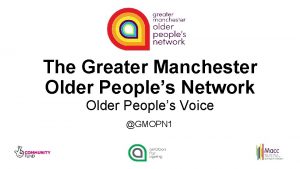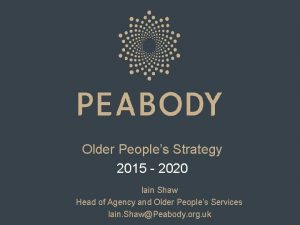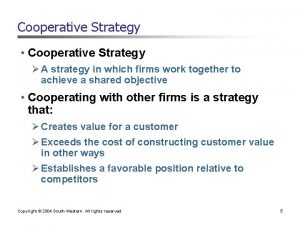Developing a New Older Peoples Strategy Older Peoples

























- Slides: 25

Developing a New Older People’s Strategy Older People’s Consultative Group 24 th March 2010

Aims of the Session • to engage key voluntary, community and statutory sector partners from across health, social care and support, housing related support, and community services in shaping the structure of the new older people's strategy • to agree a framework that will inform drafting of the new strategy prior to internal and external consultation

Background • Joint Commissioning Strategy for Older People 2005 -09 (incl. of interim one year strategy) ran until 31 st September 2009 - focus on dedicated health and social care services • Older People’s Strategy 2006 -10 runs until 31 st March 2010 - focus on a broader range of services such as those delivered by District Councils, Cultural and Community services and the Voluntary Sector

Way Forward • agreed on need for one strategy / one group • beyond dedicated health and social care services • services that have a direct impact on the quality of life of older people • clarity of outcomes/objectives and strategic direction of travel • focus on priorities for action that will have greatest impact

Next Steps • draft April 2010 • internal consultation from May 2010 • external consultation from October 2010 • release early 2011

Context Demographic Growth • extra 50, 000 aged over 65 by 2029 incl. 18, 000 aged over 85 • extra 20, 000 aged over 65 with limiting long term condition incl. 10, 000 aged over 85 • 3 % annual increase in numbers with dementia with vast majority currently undiagnosed • extra 20, 000 aged over 65 living alone by 2026 • increasing number of informal carers in need of support

Context Financial Pressures • public sector budget reductions 2011 -14 £ 21 million adult social care and £ 60 million health • Personal Care at Home Bill entitlement from October 2010 with £? million increase in costs • Social Care - £ 60 million (older people's services) • Health - £ 125 million (community based health care) • Joint Funding pot - £ 52 million

Context National Priorities • reduce health inequalities • minimise access to and occupancy of acute/community hospital beds and care homes eg falls prevention • support more people to stay at home for longer eg aids and equipment • maintain or optimise levels of independence for those with long term conditions or disabilities eg rehabilitation services • support for self care • low level prevention services • improved dementia care services • enhanced carers support • end of life support at home • personalised services offering choice and control

Key Findings Target Audience • address the needs of those aged 50 years plus ie prevention agenda • address the needs of self funders and those with needs below eligibility thresholds where they apply ie information and advice • target harder to reach groups and emphasise equality of access ie substance misusers • target isolated older people with no family/carers to offer support

Key Findings Outcomes / Objectives • quality of life / health & wellbeing - other outcomes contribute to these • maintaining independence in the home • prevention • choice and personalised services • accessible services that recognise cultural and social needs

Key Findings Structure of Support • offer a mix of low level preventative support, short term rehabilitation support, and long term care and support • be focused on delivering targeted short term personalised support based on the assessed needs of people rather than offering one size fits all long term care

Key Findings Service Priorities • information and advice • low level support at home • financial welfare • support for community groups and activities • the quality and duration of domiciliary care • self care support • community and public transport • supported housing and the role of wardens • rehabilitation or intermediate care • hospital discharge

Key Findings Evaluation • detail the framework and agree measurable outcomes in the strategy to enable us to assess quality and impact over its duration

Older People’s Services Health • acute hospitals • community based health care – health visitors, district nurses, occupational and physio therapy services • GP Practices • Stroke, Falls, Cancer, Diabetes, COPD etc • supported self care/management

Older People’s Services Social Care and Support • care homes - residential and nursing • domiciliary care • day care • telecare • aids and equipment • meals • carers support services

Older People’s Services Health and Social Care • intermediate care • health and wellbeing

Older People’s Services Housing Related Support • extra care • sheltered housing • community wardens • major adaptations

Older People’s Services Community Services • libraries • arts • adult learning • leisure centres • sports activities • community transport • community safety

Group Session 1 The strategic outcomes and objectives that will inform development/delivery of the strategy

Group Session 1 Outcomes • Improved Health & Wellbeing • Improved Quality of Life • Making a Positive Contribution • Increased Choice and Control • Freedom from Discrimination and Harassment • Economic Well-Being • Maintaining Personal Dignity and Respect Options • six other outcomes contribute to 'quality of life‘ • all seven outcomes have equal status

Group Session 1 Objectives ( Examples) • maintain independence of more people at home (given) • optimise number of people able to make informed choices regarding their health, care, and support needs • optimise the number of people supported to care for themselves or manage their conditions independently • ensure public and community transport services enable people to access key services • increase access to mainstream services for people from B M E communities • ensure people have access to social support within their community and practical support in the home

Group Session 2 Priorities for action that will achieve the outcomes/objectives set and the key partners required to support delivery of these actions

Group Session 2 Priority Actions ( Examples) • increase use of domiciliary care, including personal assistants, and reduce use of care homes • increase supply of extra care housing schemes and reduce use of care homes • enhance rehabilitation and re-ablement services to support people at home and keep them out of acute hospitals • increase range and access to low level support services in partnership with district councils and universal community services

Group Session 3 Structure, content, and title of the strategy document

Group Session 3 • vision and principles • strategic outcomes framework and strategic objectives • future needs analysis • mapping of key services/strategies that support delivery of strategy • key priorities for action • use of resources in support of delivery • governance structures and partnership working • 5 years with 3 year review ? • evaluation framework • is reference to Older People relevant ?
 Life is older than the trees
Life is older than the trees Master data management project plan
Master data management project plan Developing competitive advantage and strategic focus
Developing competitive advantage and strategic focus Customer accommodation in logistics
Customer accommodation in logistics Developing a firms strategy canvas focuses on
Developing a firms strategy canvas focuses on Developing new products and services
Developing new products and services Semitic peoples origin
Semitic peoples origin 7 habits paradigm
7 habits paradigm John calvin peoples
John calvin peoples Latin american peoples win independence chapter 8 section 1
Latin american peoples win independence chapter 8 section 1 Clap your hands all ye peoples make a joyful noise
Clap your hands all ye peoples make a joyful noise Latin american social classes
Latin american social classes Similarities between inca maya and aztec
Similarities between inca maya and aztec World council of indigenous peoples
World council of indigenous peoples The peoples populist party
The peoples populist party Chapter 11 pastoral peoples on the global stage
Chapter 11 pastoral peoples on the global stage Respect other people's time and bandwidth
Respect other people's time and bandwidth Peoples palace qmul
Peoples palace qmul Ten rules of netiquette
Ten rules of netiquette Farzana and jamil are from kustia
Farzana and jamil are from kustia Many territories and peoples controlled by one government
Many territories and peoples controlled by one government Latin american peoples win independence
Latin american peoples win independence Peoples speke
Peoples speke Peoples business
Peoples business 8 habits of stephen covey
8 habits of stephen covey Indigenous peoples
Indigenous peoples

















































